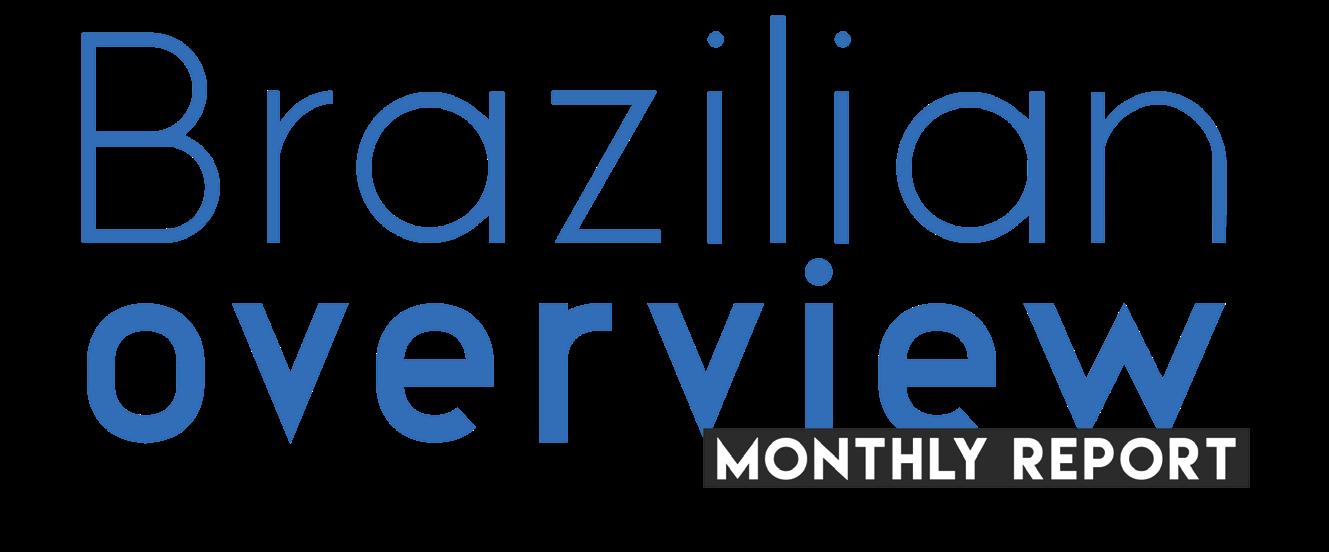










Global tensions remain high, with the United States negotiating and imposing tariffs on its trade relations with several countries. In Brazil, however, there has been a momentary relief: since the announcement of a 50% tariff hike on Brazilian imports in July, the situation has shown relative improvement, as most items have been excluded from the full tariff. Nevertheless, the risk of the crisis worsening remains, not only regarding trade with Brazil, but also due to its indirect effects, should the US government impose sanctions on Russia—a major exporter of diesel oil and fertilizers to the Brazilian market.
Despite the highly complex and uncertain environment, a combination of factors has sustained the downward trend in the exchange rate. The US dollar has been losing value against a basket of currencies on the international market, and, simultaneously, the interest rate in Brazil, currently at 15% per year, has favored the appreciation of the real, which has once again fluctuated below R$5.40. The lower exchange rate helps control inflation, which is already showing positive indicators and may even contribute to the Central Bank reducing interest rates in the near future. According to the IPCA—the official inflation index measured by the IBGE—there was a 0.26% increase in July, similar to June’s (0.24%), for a cumulative increase of 5.23% in 12 months. The main consumer group, food and beverages, continues a deflationary streak, which has contributed


to improving household purchasing power. Even the increases recorded in the month were isolated and do not characterize a trend, reinforcing the expectation that inflation will remain moderate in the coming months. These data represent relief for the economy, which sees the possibility of lowering interest rates to boost a stronger pace of growth and reverse the current slowdown. The IBCBr—an indicator that serves as a preview of GDP—indicated a 0.1% contraction in June, after remaining stable the previous month, reinforcing the perception of weakening activity. This scenario is corroborated by the decline in credit volume in certain types of loans for families and businesses, such as vehicle financing, which until recently had seen double-digit growth and is now experiencing a decline.
Sectoral data confirm this trend: retail sales fell 3% in June. Although the first half of the year ended with modest growth of 0.5%, recent months have indicated a slowdown, with a decline even in the supermarket sector (-0.5%). Industry also fell 1.3% in the same month.
The services sector, however, maintains a more favorable pace, with growth of 2.8% in June, driven by tourism, which remains resilient and represents an important pillar of support to prevent the Brazilian economy from deteriorating further. According to a monthly survey by FecomercioSP, national tourism revenue in June recorded the best result for the month since the beginning of the historical series, with an annual increase
of 5.6% and ending the first half of the year with an increase of 6.9%.
The analyses of previous BOMR reports have been confirmed: there was a positive outlook, but with a more pronounced slowdown expected at some point. With inflation projected to fall below 4.5% in the first quarter of next year, an opportunity for interest rate cuts opens up. However, both external and internal factors keep the Central Bank cautious. Internationally, the trade war could intensify, increasing country risk and making it more difficult to reduce interest rates. Domestically, the
1
Default Rate: According to the Central Bank, household default rates with more than 90 days of late payments reached 6.3% of the credit balance in June, the highest level in two years, an increase of almost one percentage point since the beginning of the year.
fiscal deficit remains out of control, and the 2026 election year could put pressure on public spending, fueling inflation and interest rates.
Brazil needs to prioritize fiscal adjustment. If it were already on track to balance its public accounts, the country would be better prepared to face the impact of a trade war, creating room to reduce interest rates, inflation, and exchange rates, stimulating investment—a key variable for robust economic growth. Therefore, the coming months will represent significant challenges, amid a clear slowdown.
2
Unemployment: The unemployment rate fell to 5.8% in the second quarter, the lowest level on record, according to the IBGE (Brazilian Institute of Geography and Statistics). Workers’ disposable income reached R$353 billion in the period, a record high in the historical series.
3
July Inflation: The general price index rose 0.26%, with pressure concentrated on specific items, such as airfare (+20%) — due to the holiday season — and residential electricity (+3.04%).
Consumer Confidence (ICC): The index fell 3.5% in July, falling from 112.9 to 108.9 points, still in optimistic territory. Despite the improvement in inflation, high interest rates hinder access to credit, and the prospect of an economic slowdown affects confidence in the medium and long term. The current level is about 15% lower than that observed in the same period in 2024.
Business Confidence in Commerce (ICEC): Increased 1.8% in July, reaching 102.8 points. However, in the annual comparison, there was a drop of 3.7%. This scenario requires attention, as the US tariff hike could harm business expectations, and high interest rates continue to impact consumption and credit.

Note: The ICC and ICEC range from 0 to 200. 100 to 200 points is considered optimistic, and below 100 points pessimistic. Although the indicators are from the city of São Paulo, they follow the trend of what is happening in the rest of the country since the city, the largest in Brazil, represents 11% of the national GDP.
United States, Europe, Argentina... Brazilians with greater purchasing power are relentless in international travel, and the numbers show it. While the domestic air network still lags behind the figures from 2015 (ten years ago) and even 2019 in many states, the number of international flights is only growing.
This year, Brazil will close with 76,200 international flights and 17.9 million seats offered. This represents an increase of 18% and 16% over 2024, respectively. These are record numbers, surpassing the highest figures of the last 10 years: 65,800 flights and 14.6 million seats in 2018.
The data comes from Forwardkeys (an Amadeus Company), which conducted a survey at the request of the PANROTAS Portal.
Total International Flights (August to December 2025)
2024: 27,873
2025: 32,501 17% Growth
Total Seats on International Flights (August to December)
2024: 6.7 million
2025: 7.6 million 14% Growth
São Paulo is the state with the most connected international destinations: 51, with flights departing from Guarulhos or Viracopos. It is the only state with two airports with scheduled international flights. It accounts for 60% of International flights and 64% of seats offered. Rio de Janeiro ranks second, with 24 connec-
ting destinations and 20% of total flights. Simply adding the flights from São Paulo and Rio de Janeiro reveals that 20% of flights remain to be distributed among 14 other airports across the country. Brasília, our capital, ranks third, with less than 4% of total international flights. See below the destinations connected to the main Brazilian cities:
1st – São Paulo (GRU and VCP, Guarulhos and Viracopos): 51 destinations
Addis Ababa, Amsterdam, Aruba, Asunción, Atlanta, Barcelona, Bariloche, Bogotá, Boston, Buenos Aires, Caracas, Casablanca, Chicago, Cape Town, Mexico City, Panama City, Córdoba, Dallas, Doha, Dubai, Fort Lauderdale, Frankfurt, Houston, Istanbul, Johannesburg, Lima, Lisbon, London, Los Angeles, Luanda, Madrid, Mendoza, Miami, Milan, Montevideo, Montreal, Munich, New York, Orlando, Paris, Porto, Punta Cana, Punta del Este, Rome, Salta, San José (Costa Rica), Santa Cruz de la Sierra, Santiago, Toronto, Washington DC and Zurich
2nd – Rio de Janeiro: 24 international destinations
Amsterdam, Atlanta, Bogotá, Buenos Aires, Panama City, Córdoba, Dallas, Dubai Frankfurt, Houston, Lima, Lisbon, London, Madrid, Mendoza, Miami, Montevideo, New York, Paris, Porto, Rome, Rosario, Santiago, and Toronto
3rd – Brasília: 9 international destinations
Bogotá, Buenos Aires, Cancun, Panama City, Lima, Lisbon, Miami, Orlando, and Santiago
4th – Recife: 8 international destinations
Buenos Aires, Córdoba, Lisbon, Madrid, Montevideo, Orlando, Porto, and Santiago


5th – Belo Horizonte: 8 international destinations
Bariloche, Buenos Aires, Panama City, Curaçao, Fort Lauderdale, Lisbon, Orlando, and Santiago
6th – Florianópolis: 7 international destinations
Buenos Aires, Panama City, Córdoba, Lima, Lisbon, Montevideo, and Santiago
7th – Fortaleza: 7 international destinations
Buenos Aires, Cayenne, Lisbon, Paris, Miami, Orlando, and Santiago
8th – Porto Alegre: 6 international destinations
Bariloche, Buenos Aires Aires, Panama City, Lima, Lisbon, and Santiago
9th – Belém: 6 international destinations
Bogotá, Cayenne, Fort Lauderdale, Lisbon, Miami, and Paramaribo
10th – Salvador: 5 destinations
Buenos Aires, Lisbon, Madrid, Montevideo, and Paris
11th – Curitiba: 5 international destinations
Asunción, Buenos Aires, Lima, Montevideo, and Santiago
12th – Manaus: 5 international destinations
Bogotá, Panama City, Fort Lauderdale, Miami, and Puerto Ordaz (Venezuela)
13th – Natal: 2 international destinations
Buenos Aires and Lisbon
14th – Porto Seguro: 1 international destination
Buenos Aires
15th – Foz do Iguaçu: 1 international destination
Santiago

16th – Maceió: 1 international destination
Buenos Aires
Source: ForwardKeys (an Amadeus Company)
DOMESTIC NETWORK
Also according to data from ForwardKeys, Brazil has not yet reached the highest number of domestic flights ever recorded, which was 916,739 in 2015. In 2018, we reached the second-highest level, with 802,503 flights offered by Brazilian airlines. In 2019, which we use as a pre-pandemic reference, there were 799,788. This year, there are 784,969 flights (including those already operated and those scheduled until the end of the year). In other words, we have not yet even recovered the pre-pandemic network in terms of flight numbers.
In terms of the number of seats offered, Brazil is close to reaching the highest level, reached in 2015. So far this year, there are 126,571,208. Ten years ago, this number was 128,528,242. The lowest number of seats recorded was in 2020, when 59,249,018 were made available due to the Covid-19 pandemic. However, the number of seats has recovered since 2024. This year, there are 126 million seats, compared to 118 million in 2019.
Only 10 Brazilian states have recovered their domestic network compared to the peak ten years ago: São Paulo, Minas Gerais, Pernambuco, Santa Catarina, Goiás, Alagoas, Paraíba, Sergipe, Acre and Roraima.
Corporate travel agencies recorded sales of R$1.23 billion in July of this year, an 8.69% increase compared to July 2024, when they reached R$1.13 billion. The performance in the seventh month of 2025 showed a shift from the stable trend compared to 2024, which had been ongoing until June.
The data comes from the Brazilian Association of Corporate Travel Agencies (Abracorp), which analyzes 11 market sectors monthly, based on the revenue of its member corporate travel agencies (TMCs).
While in the first half of the year, the revenue of Abracorp member TMCs was 2.8% lower than the same period in 2024, July begins to demonstrate a new level of growth, in the association’s view.
Geopolitics, with wars in Israel, Ukraine, and Russia, among other conflicts, continues to dictate the flow of international tourism, and Brazil is no exception. Wars and political instability continue to drive away tourists, who seek destinations outside this conflict-ridden world.
But a world at war isn’t the only concern for Brazilians, who now face a scenario of uncertainty when planning a trip.
What worries Brazilians today:
• Wars around the world and political instability that could lead to conflicts
• A strong dollar, which makes travel more expensive
• New US government measures for travel to the US, including an extra US$250 visa fee, the need
for interviews to renew some types of visas, stricter student visa requirements, and vetting the social media accounts of some visa applicants.
• The cost of accommodation, especially in Europe.
• The launch of electronic visas in the European Union and the United Kingdom.
• The 2026 elections in Brazil and the effects of the trade war with the United States. How will the tariff hike affect costs in the country?
• Many companies are already holding back costs for the coming months, given the uncertainty, which also includes how artificial intelligence will affect sales processes, jobs, and business in general. Some predict that domestic travel will grow in this scenario, but if asked, travelers will say they still want to travel abroad—and will continue to do so.
Rising trends: Visa-free travel
Luxury Cruises
Travel within Brazil
Sports Concerts
Short-haul destinations (2026 will see 11 long weekends in Brazil)
This report is produced by PANROTAS and FECOMERCIOSP to support your business decisions. The contents are valuable assets to Destinations and Travel Organizations, both domestic as well as international. For further information please contact ri@fecomercio.com.br redacao@panrotas.com.br


